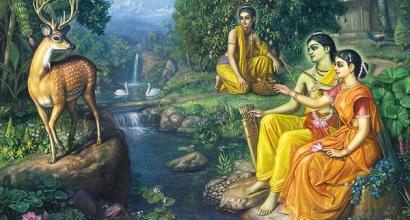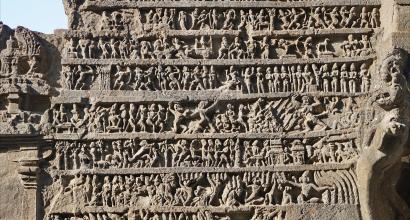Nāṭaka, prakaraṇa, bhāṇa, prahasana, ḍima, vyāyoga, samavakāra, vīthi, aṅka, and īhāmṛga – these constitute the ten rūpakas, i.e., the ten different genres of Sanskrit drama. The following are their main features as per the Nāṭyaśāstra and Sāhitya-darpaṇa.
Nāṭaka – The vastu (theme) of a nāṭaka is required to be prakhyāta, i.e., must be a popular one. This kind of rūpaka is required to contain stories that capture happiness, sadness, tranquillity, and growth. A nāṭaka has anywhere between five and ten aṅkas (acts) and contains all the five sandhis. The nāyaka is dhīrodāta, rājarṣi (a noble, saintly king), and is of divine or semi-divine origin. He has about four or five associates who aid him in achieving his task. A nāṭaka may evoke several different rasas. However, śṛṅgāra or vīra is usually the primary rasa of the play and the other rasas occur as its limbs. Adbhuta-rasa gets evoked towards the conclusion of the play. The structure of a nāṭaka is like a go-puccha – a cow’s tail. The different segments of a play paint an engrossing picture of the nāyaka, his wife, the ministers, and many other characters. The plot does not branch out into too many sub-narratives; all events that come as parts of the play get knitted together into a meaningful whole. As the focus is primarily on the ultimate outcome, other smaller branches of the story converge into a holistic end. Monologues, dialogues, and the verses that constitute the vācika of a nāṭaka are usually straightforward to understand. The dialogues usually occur in the form of short and simple sentences, just like our everyday conversations.
Each aṅka is related to the kathā-bīja and contributes towards the growth of the seed. The aṅkas in a nāṭaka are usually not too long and aesthetics have always suggested that playwrights optimize the length of an act. The nāyaka and a couple of his associates occur in every act. At the end of the aṅka, the characters naturally leave the (assumed) place.
The Abhijñāna-śākuntalam of Kālidāsa and Mudrārākṣasa of Viśākhadatta are fine examples for a nāṭaka.
It would not be wrong to say that the nāṭaka is prakṛti (the basis, foundation) and the other rūpakas are its vikṛtis (derivatives)
Prakaraṇa – The prakaraṇa has a worldly theme that is created by the poet; the events that occur in a prakaraṇa are realistic and are devoid of mystical elements. Śṛṅgāra is the main rasa. The nāyaka is a brāhmaṇa, mantri (a minister), or vartaka (a merchant); he is intelligent, wise, courageous, and tranquil by name and thus falls under the category of dhīra-praśānta. He pursues the trivarga, i.e., dharma, artha and kāma. Usually, the story of a prakaraṇa constitutes the life of a wealthy merchant, who loses his wealth due to the sinking of his trading ships or robbery. The nāyikā is either born to a noble family or is a veśyā (prostitute). At times, both kinds of nāyikās are present. In this genre of rūpaka, viṭas, ceṭas, gamblers, rowdies and many other kinds of characters come as a part of the story. The prakaraṇa is like the nāṭaka in the rest of its features. Mṛcchakaṭika of Śūdraka and Mālatīmādhava of Bhavabhūti are good examples of plays belonging to this genre.
Bhāṇa – A bhāṇa is usually based on an utpādya-vastu i.e., a theme that is created by the playwright; in most cases, it portrays the story of a wicked person. It consists of one aṅka only and a viṭa, who is smart and intelligent is the only character on the stage. Through ākāśa-bhāṣita, he conveys his own thoughts and experiences as well as those of the other (invisible) characters. Through the description of valour and beauty, vīra and śṛṅgāra rasas are evoked. A bhāṇa only has the mukha- and nirvahaṇa sandhis and has ten lāsyāṅgas. Bhāratī vṛtti dominates through out the presentation. Example – Līlā-madhuraka-bhāṇa.
Prahasana – The theme of a prahasana is conceived by the poet and it is the story of characters who represent baser values. Hāsya is the primary rasa of a prahasana as suggested by its name; sandhis, sandhyaṅgas, lāsyāṅgas, aṅka, and other features are just as they are present in the bhāṇa. Vīthyaṅgas may either be present or absent. Ārabhaṭī vṛtti is completely absent in this genre of play. Vishkambhaka and praveśaka occur in a prahasana
A prahasana is of three kinds – śuddha, saṅkīrṇa and vikṛta. In a śuddha-prahasana (‘pure comedy’), a tapsavī, a brāhmaṇa or a guru is the nāyaka. A saṅkīrṇa-prahasana (‘complex-comedy’) has stories of corrupt individuals. A vikṛta-prahasana (‘deformed-comedy’) has eunuch, kañcuki, tāpasa, bhujaṅga (rowdy), bhaṭa (soldier, guard) and other characters. For example – Kandarpa-kelī, Dhūrta-carita, and Laṭakamelaka
The current series of articles is an enlarged adaption of Prof. A. R. Krishnasastri's Kannada treatise Saṃskṛta-nāṭaka. They are presented along with additional information and footnotes by Arjun Bharadwaj.














































